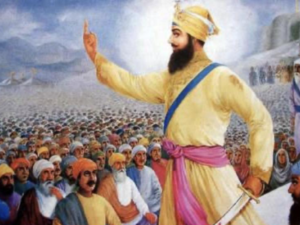Bhai Nand Lal Goya (1633–1713) was a prominent 17th-century Persian poet, scholar, and Sikh mystic, celebrated for his deep devotion to Guru Gobind Singh Ji, the tenth Sikh Guru. Originally from Ghazni, Afghanistan, he hailed from a family of Persian nobility and was well-versed in Persian and Arabic. Nand Lal came to India in search of spiritual guidance and eventually became one of the most devoted disciples of Guru Gobind Singh.
His poetry, composed mainly in Persian, reflects a profound sense of devotion and a mystical yearning for divine union, often addressing themes of love, humility, and spiritual awakening. His most famous works include Diwan-e-Goya and Zindaginama, which blend Islamic Sufi ideas with Sikh teachings, showcasing the Guru as a divine manifestation. Bhai Nand Lal’s writings are revered within Sikhism and are regarded as an integral part of the Sikh literary and spiritual tradition, often read alongside the Guru Granth Sahib for their poetic beauty and philosophical depth. His legacy endures as a bridge between Persian and Sikh literary traditions, highlighting his role as a syncretic figure in South Asian spirituality and literature.
Bhai Nand Lal Goya, a renowned poet and devout disciple of Guru Gobind Singh, is known for his deep spiritual devotion and literary excellence in Persian poetry. Two of his notable poems, Murshed-i Kamil and Saltanat-i Awwal Guru Nanak, reflect his reverence for Sikh Gurus and his insightful understanding of spiritual teachings.
1. Murshed-i-Kamil
This poem by Bhai Nand Lal Goya praises Guru Nanak as the perfect spiritual guide (Murshed- i-Kamil) and explores his boundless spiritual wisdom and grace. Written in a profound, mystical style, it reveals the poet's deep reverence for Guru Nanak, acknowledging his teachings as a timeless, divine force that transcends earthly and celestial realms.The phrase Murshed-i- Kamil suggests that Guru Nanak is the ultimate guide, possessing both spiritual knowledge and moral perfection. According to the poem, Guru Nanak’s single utterance is itself a revelation, a spark of truth that manifests God’s infinite grace , encompassing both this world and the next. The repetition of the divine name reflects the Sikh tradition of Naam Simran, or the continuous remembrance of God, through which one gains spiritual elevation.
The poet describes Guru Nanak’s word as an all-pervading force that resonates through the heavens and earth, an eternal teaching that transcends time and space. He uses metaphors of wind, fire, and celestial spheres to illustrate the magnitude of Guru Nanak’s impact, portraying it as a divine vibration that connects all aspects of creation , beyond both material and spiritual realms .
The poem emphasizes that those who immerse themselves in Guru Nanak's teachings rise above earthly pleasures and even the paradise of heaven , gaining insight into the mysteries of both worldly and divine realities. In the closing lines, Bhai Nand Lal Goya implies that Guru Nanak’s teachings provide sustenance and joy to all beings, offering a path to transcendence and fulfillment that infuses life with profound meaning. Through this mystical ode, Bhai Nand Lal Goya portrays Guru Nanak’s wisdom as a timeless, transcendent force, emphasizing that one who follows this path reaches a state beyond worldly and heavenly delights, embodying a life of pure devotion and spiritual awareness.
2. Saltanat-i-Awwal Guru Nanak
In Saltanat-i- Awwal Guru Nanak, Bhai Nand Lal explores the spiritual sovereignty of Guru Nanak, the first Sikh Guru, whom he reveres as a king of spiritual realms. This poem reflects on Guru Nanak’s teachings as foundational, portraying him as a divine monarch who established the eternal kingdom of truth and spiritual wisdom. Bhai Nand Lal describes how Guru Nanak’s message of oneness and compassion transformed society, bringing light to an era dominated by ignorance. The poem expresses profound respect for Guru Nanak’s legacy and the timeless sovereignty of his spiritual authority.
The passage from Bhai Nand Lal Goya offers profound reverence to Guru Nanak, celebrating him as “Shah Nanak Haq-Kesh” (Sovereign Nanak, Truth) and as a beacon of divine wisdom. The verses praise Guru Nanak’s spiritual authority, which transcends earthly and celestial realms, uniting both angels and mortals in devotion. Goya describes himself as a humble servant, bound to Guru Nanak’s path of truth, and emphasizes that Guru Nanak’s followers, including sages and mystics, find refuge in his grace.
Goya depicts Guru Nanak’s teachings as the ultimate guidance, illuminating a path away from illusions and toward spiritual clarity. He rejects worldly attachments, asserting that all true enlightenment and liberation stem from Guru Nanak’s wisdom. The passage reflects a deep submission to divine love, where Guru Nanak is recognized as a universal guide, and the devotees seek to dissolve their individual selves within the divine.
In the poet’s view, the teachings of Guru Nanak are not merely spiritual but a transformative force capable of awakening the soul to transcendental truths. This translation, collected in Kulliyat Bhai Nand Lal Goya, captures a vision of the Guru’s enduring influence, inspiring not only individual devotion but also guiding the entire world toward divine unity. Both poems embody Bhai Nand Lal’s poetic finesse and his deep-seated devotion, capturing the essence of Sikh spiritual leadership in eloquent Persian verse.





